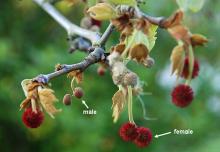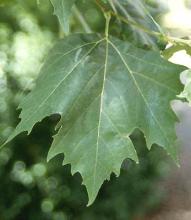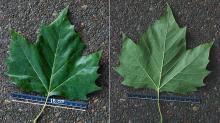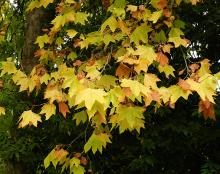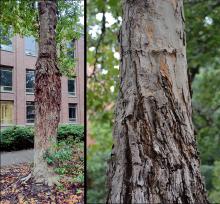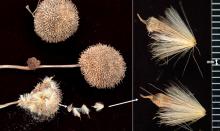Platanus acerifolia
Common name:
London Planetree
Pronunciation:
PLAT-a-nuz a-ser-e-FO-lee-a
Family:
Platanaceae
Genus:
Synonyms:
Platanus × acerifolia
Platanus × hispanica
Platanus hybrida
Type:
Broadleaf
Native to (or naturalized in) Oregon:
No
- Broadleaf deciduous tree, 70-100 ft (21-30 m), open, spreading with age. Bark exfoliates and is cream, olive, light brown, best asset of the tree. Leaves alternate, simple, 3-5 lobed, 15-18 cm x 20-25 cm, triangular-ovate or broad triangular, margins may be toothed to entire. Flowers appear in spring, in dense globose clusters, monoecious, and male (yellowish) and female (reddish) clusters are somewhat similar in appearance. Fruit is a small achene, many densely packed into globose clusters about 2.5 cm in diameter, they remain on the tree long after leaves have fallen.
- Sun or light shade. Prefers deep, rich, moist, well-drained soil, but will grow in about anything. Withstands high pH, and pollution, and grime of cities. Susceptible to anthrachnose and powdery mildew, which may disfigure the leaves in early summer. Widely planted in London. It withstands heavy pruning and is frequently pollarded.
- Hardy to USDA Zone 4 Found growing in London in 1663, a cross between Platanus orientalis (Oriental Planetree) and Platanus occidentalis (American Sycamore). Platanus × acerifolia can be very difficult to distinguish from its American parent. Distinguishing features include: P. × acerifolia leaves have deeper sinuses, lobes of leaves are about as long as wide (P. occidentalis lobes wider than long), and fruit clusters are mostly in pairs (P. occidentalis clusters mostly solitary).
- Often listed as Platanus × acerifolia in accordance with its hybrid nature. However, World Flora Online (WFO) as of 2024 lists the accepted name as Platanus acerifolia. Synonyms include Platanus × hispanica and Platanus hybrida.
-
Several selections available, including:
- ‘Bloodgood’- an old and popular cultivar that has a reputation for having anthracnose resistance. This selection is somehow linked to the James Bloodgood & Co. Nursery of Long Island, New York, which ceased business in 1919. The tree apparently was being propagated from cuttings long before it was named in 1900 by the Meehan nursery in Pennsylvania (Jacobson, 1996).
- Exclamation™ (‘Morton Circle’) – a more recent selection that was developed at the Morton Arboretum, Lisle, IL. It is reported to be resistant to anthracnose and moderately resistant to powdery mildew. The original plant has been under observation since 1994.
- Platanus: the Greek name for Oriental Planetree (P. orientalis). acerifolia: leaves like those of Acer (maple).
- Oregon State Univ. campus: many on Jefferson Ave., east of 15th St.
Click image to enlarge


